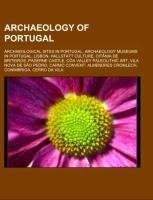
-
 Anglický jazyk
Anglický jazyk
Archaeology of Portugal
Autor: Source: Wikipedia
Source: Wikipedia. Pages: 29. Chapters: Archaeological sites in Portugal, Archaeology museums in Portugal, Lisbon, Hallstatt culture, Citânia de Briteiros, Paderne Castle, Côa Valley Paleolithic Art, Vila Nova de São Pedro, Carmo Convent, Almendres Cromlech,... Viac o knihe
Na objednávku, dodanie 2-4 týždne
13.41 €
bežná cena: 14.90 €
O knihe
Source: Wikipedia. Pages: 29. Chapters: Archaeological sites in Portugal, Archaeology museums in Portugal, Lisbon, Hallstatt culture, Citânia de Briteiros, Paderne Castle, Côa Valley Paleolithic Art, Vila Nova de São Pedro, Carmo Convent, Almendres Cromlech, Conímbriga, Cerro da Vila, Abrigo do Lagar Velho, Lapedo child, National Archaeology Museum, Anta Grande do Zambujeiro, South-Western Iberian Bronze, Roman Ruins of Villa Áulica and Convent of São Cucufate, Museu da Lourinhã, Asturian culture, House of the County, São João de Valinhas, Castro do Vieito, D. Diogo de Sousa Museum, Póvoa de Cós. Excerpt: Lisbon - a.new,#quickbar a.new/* cache key: enwiki:resourceloader:filter:minify-css:5:f2a9127573a22335c2a9102b208c73e7 */ Lisbon During the Neolithic, the region was inhabited by Iberian tribes, who built religious and funerary monuments, megaliths, Dolmens and menhirs, which still survive in areas on the periphery of Lisbon. The Indo-European Celts invaded after the first millennium BC, mixing with the Pre-Indo-European population, giving a rise to Celtic-speaking local tribes such as the Cempsi. Archaeological findings suggest that there was Phoenician influences dating back to the 1200 BC, leading some historians to believe that a Phoenician trading post might have occupied the centre of the present city (on the southern slope of the Castle hill). The sheltered harbour in the Tagus River estuary, was an ideal spot for a settlement and provided a secure port for provisioning of Phoenician ships travelling to the Islands of Tin (modern Isles of Scilly) and Cornwall. The new city might have been named Allis Ubbo, Phonecian for "safe harbour", according to one of several theories on the origin of Lisbon's toponymy. Another theory suggests that the settlement took the name of the pre-Roman word for the Tagus (Lisso or Lucio). The Tagus settlement was also an important output on commercial trade with inland tribes who collected valuable metals, salt, salted-fish, and the Lusitanian horses (that were renowned in antiquity). Although Phoenician remains from the 8th century BC were found beneath the Mediaeval Sé Cathedral, modern historians however, believe that Lisbon was an ancient autochthonous settlement (Roman oppidum) and that, at most, it maintained commercial relations with the Phoenicians (accounting Phoenician pottery and artefacts). Lisbon's name was written Ulyssippo in Latin by the geographer Pomponius Mela, a native of Hispania. It was later referenced as "Olisipp
- Vydavateľstvo: Books LLC, Reference Series
- Rok vydania: 2015
- Formát: Paperback
- Rozmer: 246 x 189 mm
- Jazyk: Anglický jazyk
- ISBN: 9781157769644




 Nemecký jazyk
Nemecký jazyk 






